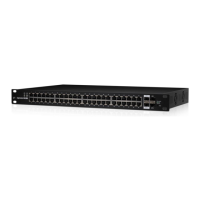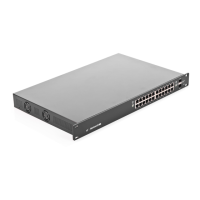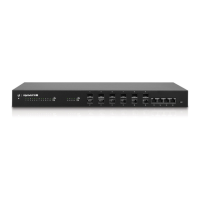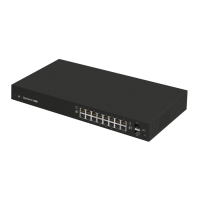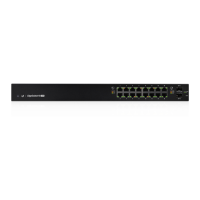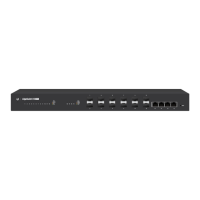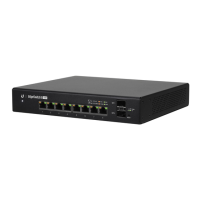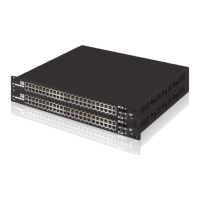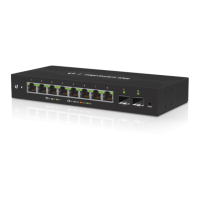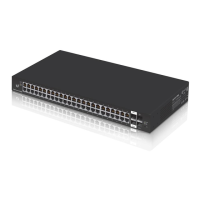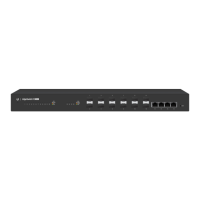
Do you have a question about the Ubiquiti ES-48-750W and is the answer not in the manual?
Explains the document's purpose, intended audience, and required prior knowledge for effective use.
Details the structure of the guide, outlining the chapters and their respective page numbers.
Lists the specific Ubiquiti products and models covered in this command reference.
Defines the typographical conventions used throughout the document for clarity and consistency.
Describes the structure of CLI commands, including keywords, required, and optional parameters.
Explains the symbols and formatting used to distinguish between mandatory, optional, and keyword parameters.
Details common parameter values, including IP addresses, slot/port naming, and character string formatting.
Explains the different CLI command modes and their corresponding prompts, allowing navigation and command execution.
Covers features for controlling CLI output, including pagination and filtering based on include/exclude strings or sections.
Guides users on how to access command and keyword help by using the question mark (?) at the command prompt.
Covers commands for configuring logical interfaces for management access, including IP addressing and network protocols.
Details commands for configuring and viewing Telnet settings, enabling remote management access.
Explains commands for enabling and configuring SSH access to the switch for secure remote management.
Provides commands for adding, managing, and deleting system users, including password strength and lockout configurations.
Covers commands for configuring Simple Network Management Protocol (SNMP) on the switch for network monitoring.
Describes commands for configuring RADIUS server for authentication and accounting on the switch.
Details commands for configuring TACACS+ for access control, authentication, authorization, and accounting.
Enables automatic update of image and configuration via TFTP server using DHCP option 125.
Provides commands to view system features, components, configurations, ARP tables, and event logs.
Covers commands for configuring system logging, viewing logs, and managing logging settings, including buffered, syslog, and email alerts.
Includes commands for troubleshooting connectivity and restoring factory defaults, such as traceroute, clear config, and ping.
Allows configuration of system time, date, Time Zone, and Summer Time settings for accurate timekeeping.
Provides commands to configure DHCP server settings, including address pools, client identifiers, and network parameters.
Helps troubleshoot IP address conflicts by triggering detection and clearing conflict status information.
Enhances network engineer capabilities for diagnosing conditions by capturing CPU packets for trace.
Covers commands for viewing and configuring port settings, including auto-negotiation, media type, and shutdown.
Describes commands to configure Spanning Tree Protocol (STP) to prevent network loops and instability.
Provides commands for configuring VLAN settings, including database, naming, and frame acceptance modes.
Details commands for configuring and viewing storm-control to protect against traffic storms and performance degradation.
Covers commands for configuring port-channels (LAGs) to combine multiple Ethernet links for increased fault tolerance and load sharing.
Describes commands to configure static MAC filtering, allowing destination port configuration for multicast MAC filters.
Covers commands for configuring and viewing Address Resolution Protocol (ARP) information and managing the ARP cache.
Provides commands to enable and configure IP routing on the switch, including interface configuration and default gateway settings.
Details commands for configuring IP routing policies, including route maps, prefix lists, and IP access lists.
Covers commands to view and configure Router Discovery Protocol settings for discovering routers on the subnet.
Describes commands to view and configure VLAN routing and status information.
Provides commands to configure BootP/DHCP Relay on the switch for forwarding DHCP requests and replies between clients and servers.
Covers commands to configure and monitor the IP Helper agent for relaying UDP broadcast packets to servers.
Describes commands to configure options for transmitting various types of ICMP messages, including rate limiting.
Allows management via IPv6 address, static assignment of addresses, and pinging IPv6 link-local addresses.
Provides commands to create, delete, and manage loopback interfaces, which are always expected to be up.
Describes commands to configure and view Class of Service (CoS) settings to control traffic priority and transmission rate.
Covers commands to configure QOS Differentiated Services (DiffServ) by defining classes, policies, and services.
Provides commands to define traffic classification by specifying Behavior Aggregate (BA), DSCP, and Multi-Field (MF) classes.
Details commands to specify traffic conditioning actions like policing and marking, applied to traffic classes.
Displays configuration and status information for DiffServ classes, policies, and services.
Covers commands for configuring MAC Access Control List (ACL) settings to ensure authorized access and block unwarranted attempts.
Describes commands to configure IP Access Control List (ACL) settings for resource access control and blocking unwarranted attempts.
Provides commands to configure IPv6 Access Control List (ACL) settings for authorized access and blocking unwarranted attempts.
Allows definition of specific times of day and week for ACL rule activation, enabling time-based access control.
Describes commands to configure Auto-Voice over IP (VoIP) to match VoIP streams and prioritize them.
Lists available PoE commands to display counters, clear counters, and show port configurations for Power over Ethernet status.
Lists common log messages related to core system operations, including NIM and SIM log messages.
Details log messages related to utilities like DHCP Filtering, NVStore, RADIUS, TACACS+, LLDP, and SNTP.
Lists log messages related to management functions, including SNMP, EmWeb, CLI utilities, WEB, SSHD, and SSLT.
Covers log messages related to switching functionalities like Protected Ports, IP Subnet VLANs, MAC-based VLANs, and 802.1X.
Details log messages related to Quality of Service (QoS) functionalities such as ACLs, CoS, DiffServ, and policy maps.
Lists error messages related to Broadcom components, including Broadcom USL and Broadcom issues.
Provides log messages related to the operating system, including Linux BSP, OSAPI Linux, and DHCPv4 Client logs.
Provides contact information for Ubiquiti Networks Support engineers for software, hardware, and field issue resolution.
Lists online resources for support, community forums, and software downloads from Ubiquiti.

